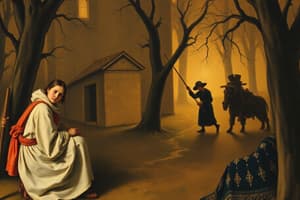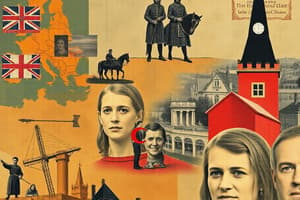Podcast
Questions and Answers
What was one of the primary military goals of the crusades called by Pope Urban II?
What was one of the primary military goals of the crusades called by Pope Urban II?
- To establish a new church
- To promote trade with Asia
- To stop Muslim attacks on the Byzantine Empire (correct)
- To conquer Europe
Which of the following was a promise made to those who joined the crusades?
Which of the following was a promise made to those who joined the crusades?
- Exemption from paying debts (correct)
- Guaranteed wealth from mercantile trade
- A title of nobility
- Permanent residency in Jerusalem
What societal development shifted power from local lords to associations of craftsmen during the Late Middle Ages?
What societal development shifted power from local lords to associations of craftsmen during the Late Middle Ages?
- The emergence of serfdom
- The start of the Guild system (correct)
- The rise of feudalism
- The establishment of monarchy
What does the term 'Burgher' refer to in the context of Late Middle Ages society?
What does the term 'Burgher' refer to in the context of Late Middle Ages society?
Which term describes the discrimination and hostility faced by Jews during the Late Middle Ages?
Which term describes the discrimination and hostility faced by Jews during the Late Middle Ages?
What is the primary obligation of nobles when the king grants them land?
What is the primary obligation of nobles when the king grants them land?
Which structure is NOT part of the feudal system?
Which structure is NOT part of the feudal system?
What system organizes society and economy around land ownership and management?
What system organizes society and economy around land ownership and management?
What type of architecture is predominantly associated with the power of the Church during the medieval period?
What type of architecture is predominantly associated with the power of the Church during the medieval period?
Which philosopher is most closely associated with Scholasticism?
Which philosopher is most closely associated with Scholasticism?
In the manorial system, what role do serfs primarily play?
In the manorial system, what role do serfs primarily play?
What was the main purpose of the Crusades?
What was the main purpose of the Crusades?
What type of functions did the Roman Catholic Church NOT perform during the medieval period?
What type of functions did the Roman Catholic Church NOT perform during the medieval period?
What were the main reasons for the emergence of the Germanic tribes during the Early Middle Ages?
What were the main reasons for the emergence of the Germanic tribes during the Early Middle Ages?
What significant event did Charles Martel achieve in the Battle of Tours?
What significant event did Charles Martel achieve in the Battle of Tours?
What was the role of the Pope in the Carolingian Empire?
What was the role of the Pope in the Carolingian Empire?
Which of the following statements accurately describes the Carolingian Empire's views on monarchy?
Which of the following statements accurately describes the Carolingian Empire's views on monarchy?
What impact did Constantine the Great's conversion to Christianity have on the Byzantine Empire?
What impact did Constantine the Great's conversion to Christianity have on the Byzantine Empire?
What was a major military issue faced by the Roman Empire before its fall?
What was a major military issue faced by the Roman Empire before its fall?
Which group was NOT one of the Germanic tribes that played a role during the Early Middle Ages?
Which group was NOT one of the Germanic tribes that played a role during the Early Middle Ages?
During the High Middle Ages, what system characterized the relationship between monarchs and nobles?
During the High Middle Ages, what system characterized the relationship between monarchs and nobles?
Flashcards are hidden until you start studying
Study Notes
The Middle Ages Overview
- Divided into three periods: Early Middle Ages (500-1050), High Middle Ages (1050-1300), Late Middle Ages (1300-1500).
Early Middle Ages
- Fall of the Roman Empire marked by Barbarian Invasions (e.g., Germanic tribes like Visigoths and Vandals).
- Military decline due to poor recruitment, reliance on mercenaries, and internal strife.
- Constantine the Great embraced Christianity to consolidate support and legalized it through the Edict of Milan.
Germanic Tribes
- Emergence linked to the decline of Rome, covering various regions:
- Spain: Visigoths
- Germany: Saxons
- Britain: Anglo-Saxons
- Italy: Lombards
- Balkans: Avans and Slavs
- France: Franks
- Motivated by political power, territorial control, military security, and social stability.
Battle of Tours
- Led by Charles Martel, halted Muslim expansion from Spain.
- Significant in preventing the spread of Islam into Europe.
Christianization
- The King of France's conversion to Christianity enabled widespread religious change, including loyalty from subjects.
Carolingian Empire and Charlemagne
- Temporal power emphasized; the church's role in legitimizing rulers through blessings from the pope.
- Concept of absolute monarchy emerged, where kings ruled by divine right.
High Middle Ages
Feudalism
- Monarchs granted land to nobles in exchange for loyalty.
- System structured into hierarchical groups: King, Lords, Knights, and Peasants.
Manorialism
- Land management system where lords governed serfs who worked the land.
- Centralized economic and social organization around land ownership.
The Roman Catholic Church
- Central in providing religious, political, economic, and social functions throughout society.
Scholasticism
- Intellectual movement emphasizing critical thinking with natural reason as a path to understanding God's existence, prominently represented by Thomas Aquinas.
Medieval Art and Architecture
- Art and Gothic architecture demonstrated the church's power and influence.
The Crusades
- A series of military campaigns by Europeans to reclaim the Holy Land (11th-13th centuries).
- Initiated by Pope Urban II aiming to restore control over Jerusalem, known as the “War of the Cross.”
- Resulted in stimulated trade and the establishment of guilds, shifting power dynamics.
Motivations for Joining
- Promised salvation, debt exemptions, and potential spoils of war.
- Goals included religious recapture of the Holy Land and military defense against Muslim incursions.
Burgher Town in Paris
- Urban centers characterized by a network of 45 towns located around a castle.
Bourgeoisie
- Emerged as a powerful urban class, influencing societal dynamics and engaging in anti-Semitism.
Late Middle Ages
- Transitionary period leading into the early Renaissance, characterized by continued changes in political, social, and economic structures.
Studying That Suits You
Use AI to generate personalized quizzes and flashcards to suit your learning preferences.




